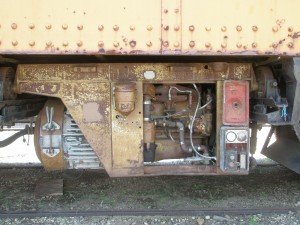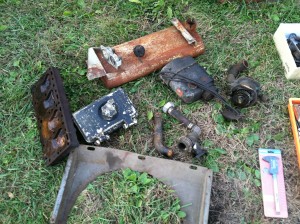It has been a few months since I’ve updated the X-5000 restoration blog. This time we have many new breakthrough developments to report.
Please see complete pictures online at: http://dyncarx5000.shutterfly.com/pictures
Beginning in early Oct. 2011 we learned that John Grube, a former Milwaukee Shops employee would be coming back to the Midwest from his new home in Boston. He agreed to spend one day with us at IRM helping us get the electrical/mechanical systems working on the Dyno car. Those familiar with the Milwaukee Shops know that John’s Father, Jack, was the Supt. of the Passenger Car Shop and responsible for work done to the business cars and Dynamometer. John followed in his Father’s footsteps, maintaining the business car fleet and Dyno at the Milwaukee Road before starting his own private railcar maintenance company post-Milwaukee Road. We were elated, as we have not been able to find anyone with the necessary experience in nearly two decades, let alone the experience of working on the Dyno at the Shops. “It’s the easiest car on the whole railroad to work on”, he remarked. My Father and I dreamed of the day when the Dyno’s systems would come back to life as in it’s former life on the Milwaukee Road. Unfortunately, he did not live to see this materialize.
A week prior to John’s arrival on Oct 14, we did a complete assessment of the Waukesha Enginator, wanting to maximize the use of his limited time. We found excessive carbon in the combustion chamber, a leaking water pump seal and a slightly leaking flexible propane hose connecting from the car to the Enginator. With 4 8V golf car batteries (32VDC) on board substituting for 4 locomotive batteries, we had tried to start it but to no avail. We were stymied.
Coincidently, at the same time the IRM Coach Dept was scrapping about a half dozen Waukesha units so I spent several hours salvaging parts such as magnetos, water pumps, temp sensors, control box, gauges, mufflers, dylinder head, cover plates, etc. Anything we thought we would need we removed.
Chuck Trabert removed the cylinder head and cleaned it up nicely. Thanks to Eric Hopp’s site http://erixrailcar.com we were able to find the part numbers for the head gasket and water pump seals. Note: for anyone wanting to learn more about Waukesha equipment, Eric has posted the manuals at http://erixrailcar.com/seminars/Waukesha%20Propane.pdf.
I replaced the leaking propane hose with the one from the Ice Engine on the car, rather than spend another $30 for a new flex hose at Home Depot. The trips to the auto store for radiator hoses, antifreeze, spark plugs, seals, gasket material, copper tubing, etc. was getting quite expensive and we didn’t yet know if it would even run or not!
Gary Olson, Larry Kuehn and Buzz Morisette helped roll the Enginator out, trace electrical connection, dragged equipment from the Coach Dept Barn 3 to the Dyno in Yard 10.
“The Gremlins are in the Ground” was quoted to me by Larry, owner of Morton Grove Auto Electric who rebuilt my alternator. When all else fails, he says, it’s probably a bad ground.
After John arrived early Sunday Oct. 24, we spent the day tracing the wiring, applying voltage at the control panel, then measuring it at the generator under the car. At one point, we were not sure we even had the polarity of the batteries correct and could not tell were it not for the fact that the 32V trainline knife switch had the polarity marked. We thought perhaps had the generator leads mixed up at the terminal block under the car. The Enginator would not crank – until – at the end of the day, after it was dark and the guys had rolled it back it, right before I disconnected the main knife switch, I tried cranking it and it cranked!! We had neglected to check the condition of the generator leads and one of them had a splice that had come loose. Now we were finally making progress!
John also noted that the 32VDC-to-115VAC Motor-Alternator (used to run the instruments, refrigerator, etc. at 115VAC) starting windings seemed to be sticking and it was not switching over to the running windings. This causes excessive current draw where the starting resistor starts glowing and makes a lot of noise.
We documented our efforts online at: http://dyncarx5000.shutterfly.com/pictures.


